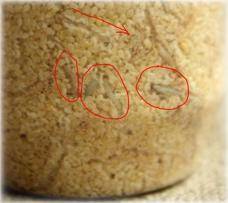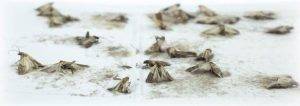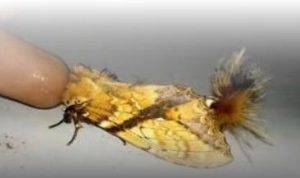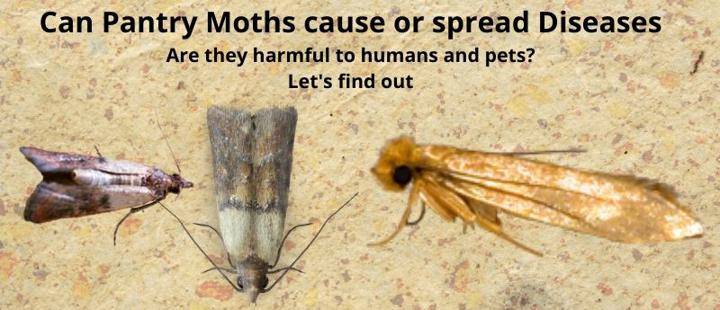Though pantry moths are not known to cause serious harm or spread diseases, they contaminate food in the kitchen or the pantry which becomes expensive to replace.
In food processing plants, the webbing caused especially by the larvae results in disgust or entry into the food.
To know if pantry moths are harmful to your health or not, we will explore some major questions behind the issue.
Let us know if moth larvae are dangerous to humans and pets, what happens when one eats a moth larva, and whether moths are safe to touch.
In this article, we seek to further know what foods do pantry moths get into and if we can eat them. We will also explore what happens if one eats a moth in the food, question whether pantry moths carry disease, and if the moths can make you sick.
By answering all these pertinent questions, we will be able to conclude for sure if Plodia interpunctella, commonly called pantry moths are harmful to humans or not.
Are pantry moths harmful?
While pantry moths are not significantly harmful they contaminate the food by leaving behind various products like eggs, larvae, and cocoons. When they find themselves in stored food, pantry moths leave by-products such as webbing, their excretion, dead bodies, and their cocoon skins.
Therefore, as much as pantry moths are not responsible for spreading diseases, they can facilitate various health issues to humans as well as be an economic burden since foods have to be replaced even if they have not expired.
What happens when you eat a pantry moth larva?
The caterpillar of the moth is as harmful as the adult. In most cases, there is no effect. Daily, there is a high probability that the amounts of caterpillars ingested are in the thousands but we are unaware.
Nothing will happen if you eat pantry moth larvae in food or the flour. When one ingests the larvae, there would be no effect on the physical state. It only affects the mental state since the pantry moths and their larvae are perceived as disgusting.

The most common caterpillar ingested is the cereal moth larvae or the Indian meal moth larvae
Actually, in some countries and cultures, these caterpillars are eaten regularly along with other insects since they are abundant compared to other types of food as well as they contain an extra source of rich proteins.
As far as the human digestive system is concerned, the pantry moth larvae might be just like any piece of animal protein that will be digested and processed. There will be no effects unless one is allergic or the larvae are poisonous to humans.
This is because the cells lining the larvae are simple compared to plant cells which makes the gastric juice produced by the stomach thrive.
It is not a surprise that Terro found that some common foods contain insects and no harm is caused.
Also, according to the Food and Drug Administration, there are acceptable levels of bugs that should be in the diet. Therefore, they are not dangerous.
Can pantry moths make you sick?
Pantry moths are the most commonly known insects to affect households. Their eggs take about 30-275 days to be completely hatched. This delay can be damaging to the health conditions of humans.
In reality, pantry moths cannot make you sick even if you eat contaminated food. Contaminated food products usually have silky webs around them as a result of the larvae.
However, eating the eggs of the Indian meal moth or the silky webs on the food products will not cause much harm.
Despite health experts saying that pantry moths do not cause harm to the health of humans many people still fear consuming them due to having a gross feeling.
As much as pantry moths do not spread diseases directly to humans it is their activity that could result in diseases in humans.
When these bugs contaminate the food they can result in bacterial decay in the affected foods. These foods when exposed to the environment where bacteria, other microbes, and fungi also exist.
In addition, they also become unfit for human consumption, and when consumed whether raw or cooked serious health problems including food poisoning might ensue.
Therefore, as much as pantry moths do not spread diseases directly to humans, they can make humans sick indirectly through contaminated food products that attract fungi and other microbes. This is only a very indirect way that pantry moths are harmful to humans.
Do pantry moths carry disease?
Pantry moths are pests that feast on processed and dried food in our homes. So what makes them a nuisance? When they infest your residence, they contaminate the packaged food as well as destroy clothes leading to an economic drain. The good news is that you can take appropriate actions to control their activities.
However, pantry moths do not carry disease. They are not known to be agents of any known disease; neither do they carry any parasite. Furthermore, the same insects do not carry any pathogens that are a threat to human health.
Despite their harmless nature, house moths including pantry moths are increasing and need to be controlled. In April this year, the British Broadcasting Corporation revealed a study done by English Heritage in England showing that the percentage of cloth-eating moths increased by twice in five years.
A pantry moth, also known as the Indian Meal Moth majorly exists in the U.S. They usually feast on food found in a cupboard or pantry. The risk areas where they can invade are:
- Food processing plants
- Kitchen
- A store that sells food

Signs to know you have pantry moth infestation
One symptom that your food is under attack is when you pour your cereals and discover a younger worm. As if that is not enough, the larva can gradually transform into an adult state. However, other signs of infestation are as follows:
- Webbing on the packaging or in cabinets.
- Little worms in food sources.
- Seeing small moths flying around the house.
One may wonder, what attracts pantry moths? Most importantly, the attracting factors are foodstuffs. As noted earlier, these include bread, flour, cereals, grains, and more. Interestingly, pantry moths have a high sense of smell to locate their strategic places.
What happens if you eat pantry months of food
Here is the scary part: Pantry moths can directly lay eggs on your food. There are chances that you may consume affected food like rice, powdered milk, and more, unknowingly. Still, in the process, you may eat their refuse or other waste pieces of stuff.
The above experience should not cause you to panic if you accidentally consumed live months or their larva. From an expert’s point of knowledge, pantry moths do not cause sickness when accidentally eaten.
One more biting question is; how did these moths gain access to packaged food? The critical loophole is when this food remains exposed to pests, especially during packaging or production.
The affected food may no longer be fresh since the reproductive life cycle that happens within food particles and damages it.
What Foods do Pantry Moths get into?
Pantry moths prefer areas with food so as to give their offspring the best chance at survival. To locate a food source, these moths depend on the sense of smell.
Pantry moths affect dry foods, especially flour and grains, which is why they are referred to as cereal grain moths. These include all cereal products, pet foods, seeds, nuts, dried milk, dried fruits, and whole grains.
Foods that are contaminated by the pantry moths might be stale and not fit for consumption. It is advisable that these foods are disposed of. However, these foods can also be salvaged.
The salvage process involves killing the harmful microorganisms by subjecting the foods to extreme heat in the oven at between 120o-130oC to sterilize for 30 minutes to 1 hour.
Alternatively, the food products can also be heated in the microwave for five minutes, submerging them in boiling water for six to 10 seconds or freezing them at zero degrees for four days. You can then sift the foods to remove the moths.
Are Pantry Moths Harmful to Humans?
Moths usually attack human food. As discussed earlier, some moths are not harmful, while others pose a real threat to human existence.
Pantry moths are not dangerous to humans because they do not cause any significant harm to people. When they infest the food, no significant contamination can happen. Moreover, the whole scenario may be a nuisance. One essential remedy to take when an infestation occurs is to discard any affected food.
While they do not cause any significant harm to people, it is good to understand why we may not like them either. How dangerous can moths be? The following points will give us some insights on how dangerous moths can be:
- Some people experience an allergic reaction by touching their fabrics or infested foods.
- Consumption of moth-infested food may sometimes lead to intestinal complications.
- The food contamination through their cocoons and poop.
Remarkably, they can eat their way into tiny plastics and contaminate the inside food. Picture this; when they infest single foodstuff, they will spread quickly to the whole room and eventually the entire house.
Moths can travel as well as crawl to cover a full area. They may begin their journey from infested pantry food and spread to the entire block and many houses. It is a plague if you do not take proper measures to prevent their spreading.
People use mothballs, which are solids that release vapor to repel and kill moths. Caution is necessary since they can harm your pet leading to mothball poisoning.
Are Pantry Moths Harmful to Pets
Indian meal moth is known to inhabit pet foods. The moths may gain access to your dwelling through the affected pet packages. They lay eggs that hatch into larvae, thereby damaging the packed food.
Pantry moths are not dangerous to pets. Even if they infest your pet food, do not fear since they don’t carry any known disease to harm your pet. This means that your dog can consume the affected food at any development stage of the moths without any potential threat. However, it is recommended that you discard such infested pet food.
Should one discover that the pet’s food has moths in them, seal up and discard? No. The sealing up exercise will control the spread of the moths to other areas. Thoroughly inspect the remaining food, if safe, freeze them for at least a week to kill eggs.
However, other types of moths can affect your pets. The following are some of the signs that the pet food could be infested by pantry moth:
- Lack of appetite by the per
- Pet spitting some food out after eating
- Not eating more often
- Inspect the food thoroughly and dump the whole bag into the airtight container.
- Dispose of contaminated food to prevent further reproduction and spreading.
- Perform a thorough clean-up on any traces of existing moths.
Can Moths bite or hurt humans?
Well, unlike other insects, the mole has a distinguishing character. Peace is their identity. Don’t be surprised to learn that most of the moth’s species lack a mouth, therefore, they cannot chew or bite.
Moths do not bite human beings or do anything significantly harmful. They can only hurt people by causing economic damage. Once they gain access to your house, they can destroy your food, and clothing and distort the entire environment at large.
Moles can stabilize the environment by causing pollination of flowers as they feed on the nectar. The in-depth meaning is our food crop may alternatively depend on the moth’s activity to enable seed production. But, you won’t starve in the absence of moths since other insects can take the mantle.
The larvae stage of a moth is referred to as caterpillar. There exists around 125,000-150,000 different species of caterpillars but very few are responsible for causing adverse reactions to humans.
The caterpillar morphology consists of hair-like projections/spikes that are connected to a venom-sac which acts as a defense mechanism.
Yes, moth larvae are dangerous to humans in a few cases, where direct contact with the caterpillar is necessary to provoke a reaction by transmitting various toxins. Some of the most lethal caterpillar species to humans are those of the genus Lonomia.

When humans touch these insects, these hair-like projections pierce our skin.
The venom from the spikes enters our bodies and results in various reactions.
These reactions could be localized. This causes skin pains, redness on the skin as well as the formation of small red bumps, contact dermatitis, and sores.
Can moth larvae cause allergy
Some people develop allergic reactions as a result of the venom. When the caterpillar is also molting, it releases some of the hair-like projections.
These spikes can be inhaled and result in respiratory distress or could land on the eye leading to a condition referred to as Ophthalmia nodosa, which is also known as the eyelid contact dermatitis.
The situation can be worse in some species since their spikes are stable in the environment for as long as one year and when humans unknowingly come into contact with them, these reactions occur.
Even though it is difficult to know the number of people affected since most reactions are mild and not reported to health centers, the effects of caterpillar venom, as well as the spines, are well known to humans.
What happens if you Eat a Moth?
The issue of eating a moth can be disturbing. Firstly, moths exist in more than 142,000 different species. Moths are part of other pantry pests that are not harmful even when eaten. However, there are edible moths and poisonous moths. For those that are edible, they are nutritious since they have high protein and low-fat content.
Nothing really happens if you eat certain types of non-poisonous moths like pantry moths. However, there are harmful species of moths that can cause dire consequences to your health if ingested.
Let’s discuss them in full detail below.
- Emperor Moth: They contain a toxic chemical known as an anti-coagulant. This chemical affects your clotting system; hence if consumed, excessive bleeding may occur. Some extreme cases may lead to death.
- Zebra Longwing Moths: This type of moth contains cyanide chemicals in their bodies which is poisonous when consumed by many mammals, including people.
- Daniid Moths: They are harmful and may produce dangerous poison. Further intake may lead to the termination of one’s life.
- Burnet Moths: Contains cyanide, a threat to human life if consumed.
Are moths safe to touch?
Being nocturnal flying insects that primarily feed on flower nectar, moths are completely inoffensive creatures that can’t bite or sting. In fact, they have many benefits for the ecosystem.
Yes, moths are generally safe to touch. Despite this, there is a fear that when humans touch moths, they tend to rub some scales off its wings making it die.

It is not the case as moths can lose their scales and still fly in fact they shed some of them during their lifetime.
However, there exist some species of moths that are potentially harmful to humans
These moths feed on poisonous substances which they store and when ingested by hungry humans can lead to the spread of diseases.
Can moths or their larvae be eaten
Moth larvae are food for a variety of insect-eating predators and effective pollinators for a number of plant species. In some parts of the world, moths are a major food source for people, too. There are some people in some countries who eat moth and butterfly caterpillars.
According to a 2004 survey by the FAO (Food and Agriculture Organization) of the United Nations, moths are packed with protein and healthy fats.
Research shows that 100 grams of these insects provide more than 100 percent of the daily requirement of some vital minerals, such as potassium, calcium, zinc, and iron. This research was confirmed practical in Central Africa in the same year.
Conclusion
Overall, pantry moths are not harmful and do not cause diseases or any known danger. However, their infestation comes with an economic loss and is similarly expensive.
One thing for sure is, that moths can only be dangerous because they spread at a very high rate. Notably, these insects can invade any place.
There are key places where these insects can hide, such as ceilings, cracks, and holes in furniture. For pantry moths extermination from your house, you need to use traps, spays, and maintain cleanliness.
In addition, before you purchase your food from any grocery shop, inspect it thoroughly. After that, store it in an airtight container or hard plastic.
Learn a few tips on how to get rid of the moths from your home


As a homeowner, I am specifically keen on home improvement. I am passionate about homes, yards, and home improvement. I blog on home ideas and reviews on solutions that make homes better.
